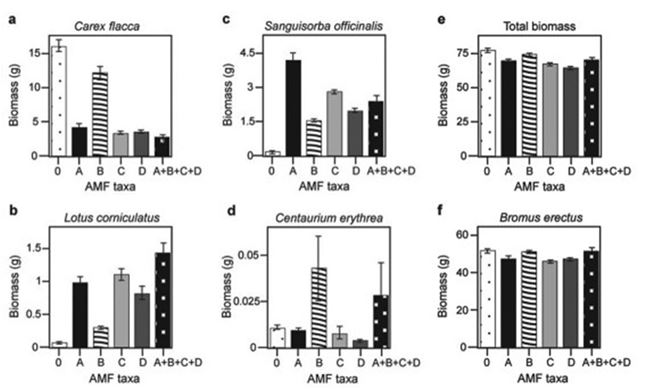Canadian and Swiss researchers wanted to know if the diversity of arbuscular mycorrhizal fungi (AMF) was important to the productivity of grasslands (M.G.A. van der Heijden, J. N. Klironomos, M. Ursic, P. Moutoglis, R. Streitwolf-Engel, T. Boler, A. Wiemken, and I. R. Sanders. 1998. Mycorrhizal fungal diversity determines plant biodiversity, ecosystem variability, and productivity. Nature 396:69-72) . Specifically, they wanted to know if it mattered which specific AMF species were present, or just that some type of AMF was present. They grew various plants in combination with one of four AMF species (A, B, C, and D) , no AMF species (O) , or all four AMF species together (A + B + C + D) ; and they measured plant growth under each set of conditions. All plant species were grown in each plot, so they always competed with each other with the only difference being which AMF species were present.
On the graphs, the x-axis labels indicate the number and identity of AMF species (bar 0 = no fungi; bars A - D = individual AMF species; bar A + B + C + D = all AMF species together) . The y-axis indicates the amount (grams) of plant biomass for the species shown in italics above each graph. Graph e is the total biomass (grams) of all 11 plant species combined; graph f is the biomass of Bromus erectus plants only, separated from the total.
Based on graphs e and f, which is the most well-supported prediction for the effect on total plant biomass if AMF diversity were increased to eight species?
A) No effect is predicted, because the dominant species is unaffected by AMF diversity.
B) Total biomass for eight species would double in comparison to that for four species.
C) Rare species would produce more biomass compared to the case when fewer AMF are present.
D) No effect is predicted, because the dominant species is non-mycorrhizal.
Correct Answer:
Verified
Q5: Fungi have an extremely high surface-to-volume ratio.
Q11: At which stage of a basidiomycete's life
Q17: What do fungi and arthropods have in
Q19: If all fungi in an environment that
Q20: Use the following information to answer the
Q21: After cytokinesis occurs in budding yeasts, the
Q23: Deuteromycetes _.
A) represent the phylum in which
Q24: Early fungi probably formed mutualistic associations with
Q26: Some nematode worms suck plant juices from
Q27: Some companies advertise and sell mycorrhizae to
Unlock this Answer For Free Now!
View this answer and more for free by performing one of the following actions

Scan the QR code to install the App and get 2 free unlocks

Unlock quizzes for free by uploading documents